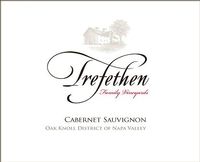Trefethen Family Vineyards, Napa Valley-Oak Knoll District Cabernet Sauvignon 2009 ($60): In tasting this wine blind and commenting on it, I found myself using the term, “restaurant wine.” That’s one of those terms that is sometimes a back-handed compliment: A wine that most people will like, a good wine to drink in certain circumstances, not necessarily a great wine but one that’s useful and serviceable. I hasten to say that I personally apply the term in only the  most complimentary way. A “restaurant wine” to me is a fine wine that’s relatively low-key for its type, a wine that seeks to accommodate food rather than stand out for its own sake, and is relatively affordable. A wine with finesse.
most complimentary way. A “restaurant wine” to me is a fine wine that’s relatively low-key for its type, a wine that seeks to accommodate food rather than stand out for its own sake, and is relatively affordable. A wine with finesse.
This Trefethen Cabernet is to me an ideal restaurant wine. It is easy to drink and easy to like, but of very fine quality. In my blind tasting it followed a duo of California Cabs that were bigger, riper, more powerful and more aggressive, not to mention more expensive. But this Trefethen is higher in quality because of its balance, depth, long reach of flavor across the whole palate, and its harmony of expression.
Trefethen Family Vineyards is one of the grand old names in the modern era of Napa Valley winegrowing. John Trefethen produced the family’s first commercial wine in 1973 with grapes from vineyards grown on his parents’ retirement farm in the cool, southernmost vineyard area of Napa Valley. His 1976 Chardonnay won the title of Best Chardonnay in the World at the 1979 Gault Millau Wine Olympics in Paris. The indomitable Janet Trefethen brought the winery to the attention of critics and the trade, and has become a leader within Napa Valley. Now their children, Loren and Hailey, are part of the business.
All Trefethen wines are estate wines, made only from grapes that the family has grown. Trefethen produces two Cabernet Sauvignons, this “signature tier” Cab and a Reserve. It also periodically markets Library releases of aged Cabernet.
This 2009 Cabernet Sauvignon is 93 percent Cabernet; the balance of the wine comes from the other classic red Bordeaux varieties, Cabernet Franc (3 percent), Malbec (2 percent) and Merlot and Petit Verdot, each at 1 percent. It has aged in a combination of French oak and American oak barrels, 81 and 19 percent respectively.
Although the aroma and flavors of this wine are low-key compared to many Napa Valley Cabs today, they are complex and vivid, showing focused notes of fresh dark berry and spice on the nose, and concentrated notes of berry, cassis, black pepper, and a slight mintiness on the palate. Structurally, the wine is particularly admirable. It’s not quite full-bodied in weight, with fine-grain tannins that frame the wine’s taste. Apart from the tannin, the texture is silky. The wine’s balance and fruit concentration are such that, when you hold the wine in your mouth, the mid-palate shows depth and energy, and when you swallow, you find no gap in the flavor toward the rear of your mouth, but a seamless flow rearward to a long, fruity finish.
I believe that this wine will improve over the next three years or so and then hold for several years. But it is eminently drinkable right now. Because it’s not pushy or showy, it can accommodate simple meats as well as more flavorful dishes.
90 Points
